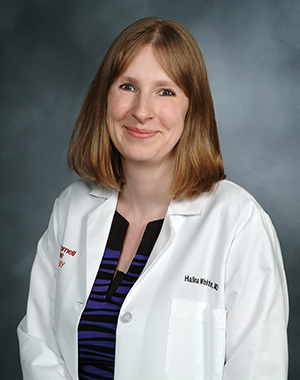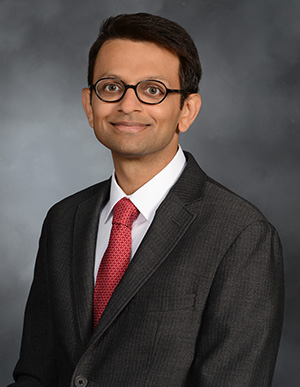In 2019, stroke specialists in the Department of Neurology at NewYork-Presbyterian/Weill Cornell Medical Center established a novel outpatient cerebrovascular protocol to accelerate the evaluation and management of patients with concerning symptoms.
The new care pathway has been designated RESCUE-TIA (Rapid Evaluation of minor Stroke and CerebrovascUlar Events including TIA) and has been implemented by faculty in the Stroke, Critical Care, and Neurohospitalist Program at Weill Cornell Medicine.

Dr. Halina White

Dr. Neal Parikh
The RESCUE-TIA team is led by Halina White, MD, RESCUE-TIA Clinic Director, supported by Neal S. Parikh, MD, MS, Director of Outpatient Stroke and Vascular Neurology, Babak B. Navi, MD, MS, Division Chief of Stroke and Hospital Neurology and Medical Director of the Weill Cornell Stroke Center, Matthew E. Fink, MD, Chairman, Department of Neurology, Paul M. Wechsler, MD, neurology resident, and neuroradiologist Linda A. Heier, MD. In the January 2022 issue of The Neurohospitalist, they provide an in-depth review covering the rationale, development, and data on their experience with the clinical pathway.
Their impetus for creating the RESCUE-TIA outpatient clinic is derived from major European studies that established the safety and cost-effectiveness of ultra-rapid outpatient management of TIA and minor stroke.
The team members have given considerable thought to the criteria for patients who could safely benefit from this service rather than going directly to an emergency department for evaluation and management. The RESCUE-TIA clinic is targeted to patients whose symptoms have resolved or are fixed, but minor and non-disabling. With this in mind, they have identified the following patient inclusion criteria:
- Patient had transient and resolved or persistent but minor unilateral weakness, unilateral numbness, unilateral facial paresis, trouble speaking, trouble seeing, dizziness, or trouble walking
- Symptoms started more than 24 hours earlier
- Symptoms are not fluctuating in intensity or getting worse
- Patient can carry out normal functions, including all basic activities of daily living, ambulation independent of others, and normal eating and swallowing
Following a telephone triage initiated by a care provider or the patient, eligible patients are scheduled for an in-person or telemedicine appointment with a stroke neurologist or supervised stroke physician assistant within 24 hours. During the appointment, full outpatient testing, which includes rapid MRI with diffusion-weighted imaging, MRA, echocardiography, Holter monitoring, and blood tests are rapidly arranged, and treatment with antiplatelet drugs, anticoagulants, and medications to control cholesterol, blood sugar, and blood pressure are begun as indicated.
Once the stroke neurologist reviews all laboratory and imaging results, patients diagnosed with symptomatic carotid stenosis or other urgent intracranial pathology are admitted directly to the Stroke Service at NewYork-Presbyterian/Weill Cornell. Those able to be discharged home are scheduled for a follow-up visit with a vascular neurologist within two to four weeks. Whether during the initial screening call or the patient visit, if the patient is considered high risk for stroke or the potential exists for stroke deficits that may result in functional impairment, patients are triaged to the ED for immediate care and intervention as indicated.
RESCUE-TIA: An Important Resource During the Covid-19 Pandemic
With the infrastructure of the RESCUE-TIA clinic already in place and offering rapid high-quality care on an outpatient basis, the physicians quickly evaluated how the pathway could be further refined to accommodate patients now hesitant to come to a hospital for fear of infection with SARS-CoV-2 despite having neurological symptoms of concern.
The RESCUE-TIA clinical pathway developed by the Department of Neurology at NewYork-Presbyterian/Weill Cornell Medical Center provided patients with access to care that would have been otherwise compromised by the COVID-19 pandemic.
In March 2020, they transitioned the program to telemedicine with patients guided on how to obtain testing in locations closer to their homes. To ensure that the team could receive timely results, the clinic’s workflow was adapted with clinic assistants compiling the results from external sources and entering them into the medical record, which allowed for efficient and comprehensive review by the stroke neurologists.
An Evaluation Clinic Model: Before, During, and After the Pandemic
The RESCUE-TIA clinical pathway developed by the Department of Neurology at NewYork-Presbyterian/Weill Cornell provided patients with access to care that would have been otherwise compromised by the COVID-19 pandemic. To better understand the program’s early impact, the team undertook a retrospective review of patients seen in the clinic between December 2019 and August 2020. A total of 21 patients were evaluated during the eight-month period, including 15 patients during the height of the pandemic, with a median age of 75 years. Their study showed:
- Telemedicine visits were used by 67 percent of patients
- Median time from clinic evaluation to laboratory diagnostics was 8 hours and imaging was completed within 1 day
- For patients evaluated after the program’s transition to only telemedicine in March 2020, median time from symptom onset to evaluation was 3 days; median time to both laboratory diagnostics and image completion was 1 day
- Final diagnoses as determined by a board-certified vascular neurologist, according to AHA/ASA definitions for diagnosing cerebrovascular events, were: TIA – 12 patients; Ischemic stroke – 5 patients; Transient global amnesia – 2 patients; Migraine – 1 patient; and Distal subarachnoid hemorrhage – 1 patient
The authors note that the low number of patients evaluated were mostly due to a small referral base as they did not promote the program widely early on and also potentially as a result of the strict inclusion/exclusion criteria felt to be necessary to ensure patient safety, as well as possible lack of patient access to technology. They conclude that the operation of the RESCUE-TIA outpatient clinic during COVID-19 represents an “improvement in stroke systems of care and may prove beneficial in the long term.”
Perhaps most tellingly, since the pilot, a further 110 patients have sought care from the RESCUE-TIA clinic, and more data will be available soon.


